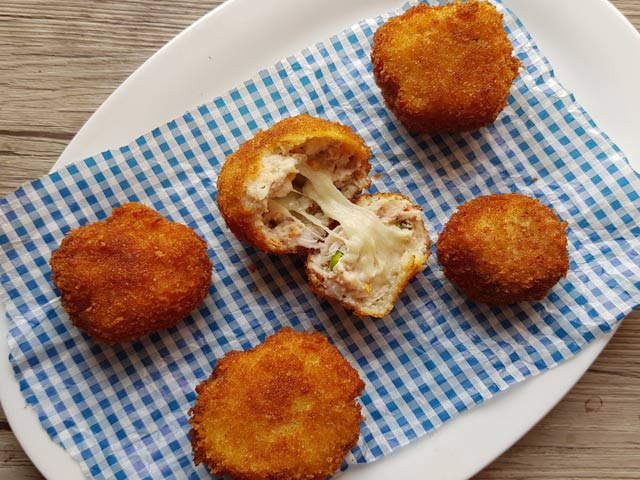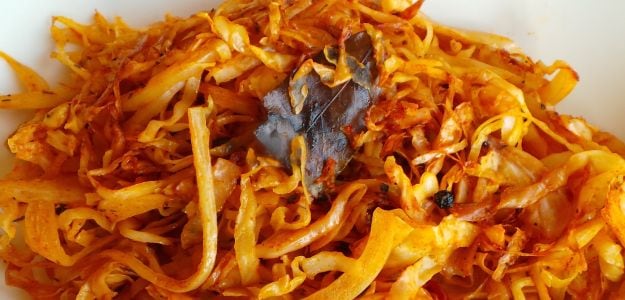Cabbage is the Rodney Dangerfield of vegetables: It doesn't get any respect. It gets a bad rap. Cabbage never gets mentioned as one of the hip vegetables like kale. It's not a super-vegetable like broccoli rabe. It's not an adorable vegetable like baby Brussels sprouts. It's not a "cool" vegetable. It's stodgy and old-fashioned. I mean, they make sauerkraut from it.
All those cooler vegetables just mentioned, though, owe their existence to cabbage. The big green head we associate with cabbage today was not always what cabbage was. Today there are hundreds of varieties of cabbage that have developed from the progenitor cabbage, called the wild cabbage, including the many forms of cabbage and further horticultural developments such as broccoli, cauliflower, Brussels sprouts, broccoli flower, broccoli rabe and kohlrabi.
Botanists divide the cabbage into five groups. It is the head cabbage, green, red, crinkly-leafed or Savoy cabbage, that I'm speaking of. But there are some 400 varieties of head cabbage.
The cabbage is probably native to the Mediterranean, but in Roman times the head cabbage we think of as cabbage today did not exist. The Romans had only leafy cabbage, probably kale. There are some obscure references by Roman naturalists Pliny and Columella to what has been taken by some to be head cabbage. These descriptions refer to heads of the plant being a foot in diameter, but it is not at all clear whether this refers to a compact headed cabbage that we know today or is simply an expression referring to the above ground portion of the plant.
The wealthy citizens of Rome, in the period after Cato the Elder (mid-second century BC), thought of cabbage as poor people's food as we know from the description in Juvenal's satire when he described the difference between the food that the patron ate, namely olives to garnish an excellent fish, and the food of the client, who finds cabbage in his "nauseous dish."
It seems that the head cabbage we know today was developed in Germany in the 12th century. Soon it would be the single most common plant in the medieval garden.
It's not a popular vegetable today, but it is a vegetable that does draw the curious cook. The most obviously intriguing thing to do with cabbage is to separate the leaves and then stuff them by rolling them up. There are many great preparations for cabbage from sauerkraut, to kimchi, to coleslaw, and every culture has a recipe for stuffed cabbage. Here are two recipes for cabbage lovers from cabbage-loving Slovenia and Croatia, next door to Italy.
Braised Cabbage
Cabbage is a very popular vegetable in the Balkans, served raw, in the form of sauerkraut and cooked in a variety of ways. In the northern part of the former Yugoslavia, today's Slovenia and parts of Croatia, cabbage may be cooked with sour cream or tossed with noodles and smoked bacon. In Bosnia or Montenegro, it might be cooked with tomatoes. This recipe from Slovenia is typically served as a bed for a roast duckling.
Prep time: 5 minutes
Cooking time: 55 minutes
Yield: 4 servings
Ingredients
4 tablespoons extra virgin olive oil
2 bay leaves
2 tablespoons tomato paste mixed with 2 tablespoons water
1 cup dry white wine
One 2-pound green cabbage, cored and sliced as thin as vermicelli
15 peppercorns
8 juniper berries, lightly crushed
1 teaspoon dried thyme
1 tablespoon fresh lemon juice
Salt and pepper to taste
Directions
1. In a large skillet, heat the olive oil over medium-high heat, then add the bay leaves and cook until they begin to sizzle. Reduce the heat to medium and very carefully add the tomato paste and wine, which will spurt and splatter rather dramatically.
2. Continue cooking for a minute then add the cabbage, peppercorns, juniper berries and thyme. Mix so the cabbage is covered with sauce.
3. Add the lemon juice and continue to braise over medium heat until the cabbage softens, 6 to 8 minutes.
4. Reduce the heat to low, season with salt and pepper, and cook until the cabbage is completely soft, about 45 minutes. Correct the seasoning and serve hot.
Stuffed Cabbage Rolls
These cabbage rolls are a winter specialty known as arambasici in their home of Sinj, a town near the Dinaric Alps on the Dalmatian coast of Croatia. Traditionally, this casserole of stuffed cabbage leaves is made from a whole head of cabbage that has been prepared as sauerkraut. Each sauerkraut leaf, or as in this recipe cabbage leaf, is stuffed with beef, pork and bacon, and flavored with lemon zest, onion, garlic, cloves and cinnamon. Each roll-up is separated from the other with pieces of prsut (Croatian prosciutto) and smoked tongue.
Arambasici can be made with fresh cabbage leaves or grape leaves, too. My recipe uses fresh cabbage, which is the easiest to find and is what a cook from Sinj would use in the summer. Many cooks also like to make the casserole in the evening and then reheat it the next day, and you should consider doing that as it is delicious.
The casserole cooks a long time so the meats are very tender and the cabbage leaves become silky. The smoked bacon, smoked pork, smoked tongue and prosciutto can all be picked up at the deli counter of most supermarkets.
Prep time: 30 minutes
Cooking time: 4 hours
Yield: 20 to 26 rolls, or about 6 servings
Ingredients
1 large green cabbage (about 2 3/4 pounds), central core removed
1 1/4 pounds boneless beef neck meat or beef chuck, finely chopped
5 ounces smoked bacon (preferably) or lean slab bacon, finely chopped
2 ounces beef fat (suet), finely chopped
6 ounces boneless pork shoulder or neck meat, finely chopped
2 large onions, chopped
3 large garlic cloves, finely chopped
Grated zest from 1 lemon
1/2 teaspoon ground cinnamon
1/2 teaspoon ground cloves
1/4 teaspoon ground nutmeg
3/4 teaspoon salt
1/2 teaspoon freshly ground black pepper
1 tablespoon unsalted butter or beef fat for greasing
One 4-inch-long beef marrow bone (optional)
1 ounce smoked pork (any cut), finely chopped
2 ounces prosciutto, thinly sliced into strips
2 ounces smoked tongue (optional), thinly sliced into strips
1 cup water and more as needed
Directions
1. Heat the oven to 300 F.
2. Remove and discard any of the outermost leaves of the cabbage that are blemished. Bring a large pot of water to a rolling boil, salt and plunge the whole cabbage in and cook until the leaves can be peeled away without ripping, about 10 minutes. Drain well and, when cool enough to handle, separate the leaves carefully, setting them aside.
3. In a large bowl, mix together the beef, bacon, suet and pork. Add the onions, garlic, lemon zest, cinnamon, cloves, nutmeg, salt and pepper and mix well with your hands.
4. Arrange a cabbage leaf in front of you with the stem end closest to you. Place 2, 3 or 4 tablespoons (depending on the size of the leaf) of filling on the end closest to you, then roll away once, fold in the sides and continue rolling away until you get a nice, neat package.
5. Continue with the remaining cabbage leaves. Arrange the cabbage rolls side by side, seam side down, in a lightly greased 13- x 9- x 2-inch casserole (you may need to use two casseroles), making sure you leave some room for the beef marrow bone. Sprinkle the chopped smoked pork over the cabbage rolls.
6. Place the prosciutto and smoked tongue slices (if using) between the cabbage rolls. Pour the water over the cabbage rolls and cover with aluminum foil. (The casserole can be refrigerated at this point to bake later.)
7. Bake until the cabbage rolls are very soft, slightly blackened on top and bubbling vigorously, about 4 hours.
8. Serve hot or let cool to room temperature and serve as an appetizer the next day.














